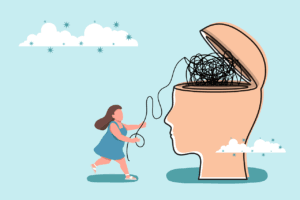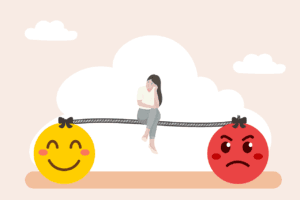Digital Mental Health: Navigating Technology for Well-Being
In today’s technology-driven world, our mental health is increasingly shaped by our interaction with digital devices and platforms. Digital mental health refers to understanding the impact of technology on well-being and implementing practices that foster balance and emotional resilience. While technology offers convenience, connectivity, and learning opportunities, it also brings stress, social comparison, and subconscious stressors. This guide explores the relationship between technology and mental health, focusing on stress management, social media use, and subconscious triggers, alongside practical solutions.

How Technology Affects Mental Health
Technology can both enhance and challenge mental well-being. While it connects us with loved ones, offers entertainment, and provides resources for self-improvement, excessive or unregulated use can lead to anxiety, depression, and burnout. Understanding these impacts is the first step toward maintaining a healthy digital lifestyle.
The Link Between Stress and Digital Habits
Stress is a response to perceived threats or demands exceeding available resources. In the digital age, stress often arises from unrealistic expectations, information overload, and constant connectivity. Identifying the primary sources of digital stress can help develop strategies to mitigate its effects.
Types of Stress
- Acute Stress: Short-term stress triggered by specific events, such as missing a deadline or receiving negative feedback online.
- Chronic Stress: Prolonged stress from constant digital demands, like excessive work emails or social media pressure.
- Stress Debt (Allostatic Load): The cumulative burden of unaddressed stressors, which can lead to long-term health complications.

Strategies to Manage Digital Stress
- Reframe Your Mindset: Focus on solutions rather than stressors. Instead of feeling overwhelmed by emails, prioritize responses based on urgency.
- Assess Your Digital Consumption: Track screen time and set limits to avoid unnecessary stress from digital overload.
- Incorporate Mindfulness Practices: Techniques like meditation and deep breathing help build resilience against digital stress.
The Role of Social Media in Mental Health
Social media plays a significant role in shaping self-esteem, emotional health, and overall well-being. While it fosters connection and information sharing, it can also contribute to anxiety and self-doubt when used excessively or passively.
Active vs. Passive Social Media Use
- Active Use: Engaging in purposeful activities like networking, content creation, and learning.
- Passive Use: Mindless scrolling, consuming endless content, and comparing oneself to others, which often leads to negative emotions.
Questions to Assess Your Social Media Habits:
- Is my social media usage intentional or habitual?
- Does it add value to my personal or professional life?
- Would I behave the same way online if a mentor or employer observed my activity?
The Influence of Algorithms
Social media algorithms prioritize engagement, often amplifying extreme content, misinformation, and divisive discussions. Understanding how algorithms shape content consumption can help users become more mindful of their digital diet.

Subconscious Stressors in the Digital World
Beyond obvious stressors, digital interactions often introduce subtle, subconscious stress that accumulates over time.
Social Comparison
- Definition: Evaluating oneself in relation to others’ achievements and lifestyles.
- Types:
- Downward Comparison: Comparing to those perceived as less successful, sometimes leading to temporary self-esteem boosts.
- Upward Comparison: Comparing to seemingly more successful individuals, which can either inspire growth or foster insecurity.
How to Manage Social Comparison
- Limit Exposure to Idealized Content: Curate your feed to follow inspiring yet realistic accounts.
- Practice Gratitude: Focus on personal progress rather than external validation.
- Set Individual Goals: Personal milestones help reduce dependence on external comparisons.
Digital Information Overload
Excessive consumption of news, notifications, and online discussions can lead to cognitive fatigue and heightened anxiety.
Solutions:
- Schedule Information Consumption: Limit news and updates to specific times of the day.
- Use Content Filters: Follow trusted sources and avoid sensationalized media.
- Prioritize Deep Work: Focus on meaningful tasks rather than reacting to constant digital stimuli.

Real-Life Examples of Digital Mental Health Strategies
Example 1: Digital Detox for Mental Clarity
Sarah, a content creator, realized her constant engagement with social media was affecting her mental health. She implemented a “digital detox weekend,” where she logged out of all social platforms every Saturday and Sunday. Over time, she noticed improved focus, reduced anxiety, and enhanced creativity.
Example 2: Mindful Social Media Usage
David, a marketing professional, found himself constantly comparing his career progress to others on LinkedIn. He decided to set a 15-minute daily limit for professional networking and shifted his focus toward skill development. As a result, his self-confidence improved, and he felt less pressure from online comparisons.
Example 3: Overcoming Zoom Fatigue
John, a remote worker, felt drained from excessive virtual meetings. He implemented walking breaks, encouraged audio-only meetings, and scheduled shorter calls. This helped him stay energized and productive.
Do’s and Don’ts of Digital Mental Health
Do’s:
✔ Set boundaries for screen time and social media usage. ✔ Engage in intentional and productive digital interactions. ✔ Curate an online environment that fosters positivity and growth. ✔ Take regular digital detoxes to reset your mental well-being. ✔ Use apps and tools that promote mindfulness and screen-time management.
Don’ts:
✘ Avoid excessive multitasking, as it reduces efficiency and increases stress. ✘ Don’t engage in online arguments or toxic discussions. ✘ Refrain from using digital devices right before bedtime to improve sleep quality. ✘ Don’t rely solely on social media validation for self-worth. ✘ Avoid excessive news consumption that contributes to anxiety and distress.
Subconscious Stressors in the Digital Age
Fear of Missing Out (FOMO)
- Definition: Anxiety about being left out or uninformed.
- Solution: Practice daily affirmations, reflect on personal priorities, and separate business-related social media use from entertainment.
Nomophobia
- Definition: Fear of being disconnected from mobile phone connectivity.
- Solution: Gradually reduce phone dependency by limiting its use in specific situations, such as during meals or before bedtime.
Phoneliness
- Definition: The urge to check your phone when alone or in social settings.
- Solution: Identify emotional triggers and replace this habit with engaging offline activities, such as reading or outdoor hobbies.
Zoom Fatigue
- Definition: Exhaustion from excessive virtual meetings and video calls.
- Solution: Set clear boundaries for video calls, take screen breaks, and prioritize in-person interactions when feasible.
Selective Exposure
- Definition: Preferring information that aligns with personal beliefs while avoiding contradictory viewpoints.
- Solution: Engage with diverse opinions and consume a broad range of content to foster intellectual growth.
Mere Presence of Devices
- Definition: The mere presence of a phone can reduce productivity and focus.
- Solution: Remove digital devices from your workspace or use the ‘Do Not Disturb’ mode during focused work sessions.
Practical Strategies for Digital Wellness
Achieving digital wellness requires awareness and intentional habits. Here are actionable strategies:
1. Set Boundaries
Designate specific times for checking emails, social media, and other digital activities. Create a tech-free zone in certain areas of your home.
2. Practice Digital Detoxes
Allocate specific periods to disconnect from all digital devices. A weekend without screens can significantly improve mental clarity and emotional well-being.
3. Engage in Mindful Practices
Incorporate mindfulness techniques such as deep breathing, meditation, and yoga to enhance mental resilience.
4. Create Healthy Tech Habits
Replace excessive screen time with activities that rejuvenate your mind, such as:
- Reading books
- Exercising outdoors
- Practicing creative hobbies (e.g., painting, writing, or playing an instrument)
5. Audit Your Content Consumption
Follow uplifting and educational accounts while muting or unfollowing sources of stress and negativity.
Frequently Asked Questions: Digital Mental Health
- What is digital mental health? Digital mental health refers to understanding and managing how technology impacts our emotional, psychological, and social well-being.
- How does social media affect mental health? Social media can offer connection and learning opportunities but also contribute to stress, comparison, and distraction if used mindlessly.
- What are subconscious stressors? Subconscious stressors are hidden triggers, like Zoom fatigue or the mere presence of a phone, that affect our mental health without our conscious awareness.
- How can I manage stress caused by technology? Reframe your mindset, set boundaries, practice self-care, and engage in activities that promote mental wellness.
- What is Zoom fatigue, and how can I avoid it? Zoom fatigue is the exhaustion from overusing virtual communication tools. To combat it, limit video calls, take breaks, and schedule non-digital interactions.
- How can I reduce my phone dependency? Start by setting phone-free times, engaging in offline activities, and gradually reducing the phone’s presence in your daily routine.
How can I reduce my screen time without affecting productivity? Use tools like app blockers and focus timers to limit non-essential digital engagement while maintaining work efficiency.
Does social media always negatively impact mental health? No, it depends on usage patterns. Active, purposeful engagement fosters learning and networking, while passive, excessive use may lead to stress and comparison.
What is a digital detox, and how often should I do it? A digital detox involves temporarily disconnecting from digital devices to reduce stress and enhance focus. A weekend detox once a month or daily breaks from screens can be beneficial.
How do I manage stress caused by constant online notifications? Turn off non-essential notifications and schedule designated times to check emails and messages
Can technology help improve mental health? Yes, many apps support mental well-being, such as Headspace for meditation, Forest for focus, and Sleep Cycle for better sleep management.
Conclusion Digital Mental Health
Understanding digital mental health is essential in today’s fast-paced, tech-driven world. By identifying stressors, adopting healthy habits, and reframing your mindset, you can cultivate a balanced relationship with technology. Take charge of your digital habits to thrive both personally and professionally.
Digital mental health is about creating a balance between technology use and well-being. By understanding stress triggers, managing social media consumption, and addressing subconscious digital stressors, individuals can harness the benefits of technology without compromising mental health. Through mindful digital habits, regular detoxes, and intentional online engagement, we can foster a healthier relationship with technology while prioritizing our well-being.


